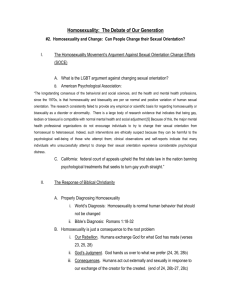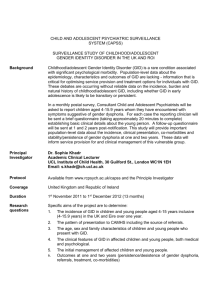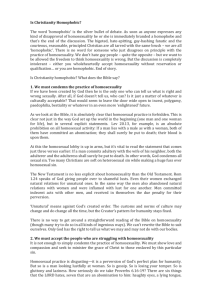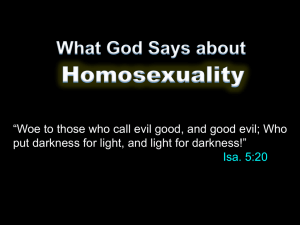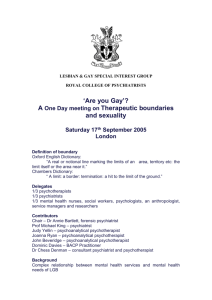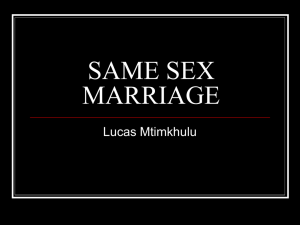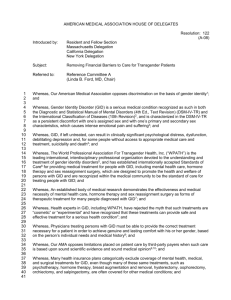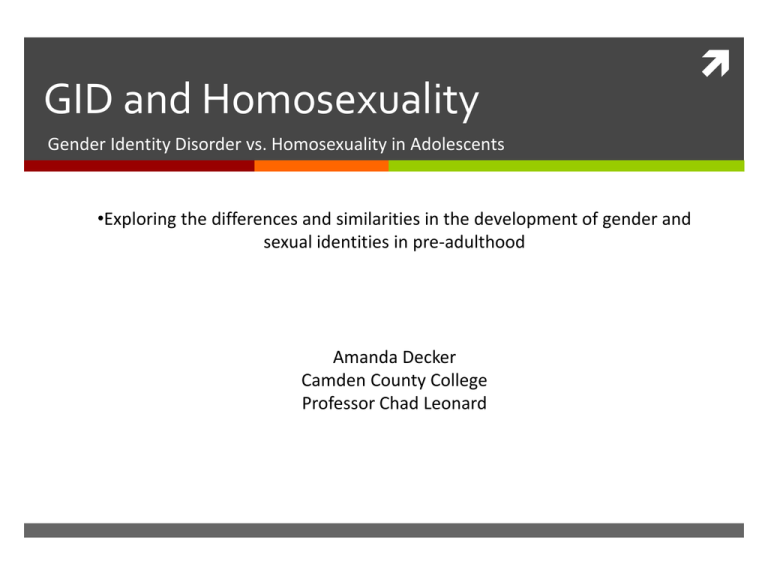
GID and Homosexuality
Gender Identity Disorder vs. Homosexuality in Adolescents
•Exploring the differences and similarities in the development of gender and
sexual identities in pre-adulthood
Amanda Decker
Camden County College
Professor Chad Leonard
Definitions and Explanations
Gender Identity Disorder and Homosexuality
Gender Identity Disorder (GID)
The developmental phenomenon where an individual
truly feels that their physical, biological gender is
incorrect. (1)
Homosexuality
The sexual attraction to the same sex; also known as
LGB (2)
(1) Simonelli, C., Rossi, R., Tripodi, M. F., De Stasio, S., & Petruccelli, I. (2006, September 25). Gender identity and
preadolescence: a pilot study. Sexologies, 16-1, 22-28
(2) Rosario, M., Schrimshaw, E., & Hunter, J. (2008, October 30). Predicting Different Patterns of Sexual Identity
Development Over Time Among Lesbian, Gay, and Bisexual Youths: A Cluster Analytic Approach.
American Journal of Psychology, 42-3,4, 266-282.
Research Topic
Comparing the development of homosexuality and
gender identity disorder in pre/post adolescents.
How do they differ?
How are they recognized?
Are there age differences when they appear?
Homosexuality
156 youths from New York City area.
14-21 (Mean age was 18.3)
49% female, 51% male
34% low SES, 66% high SES
Self-defined Sexual Orientations
66% Lesbian or Gay
31% Bisexual
3% Unsure
Homosexuality
Interview/Survey Study
Interviewed two times- one year apart
Utilized “Sexual Risk Behavior Assessment – Youth
(SERBAS-Y)” and Identity Integration Checklist
Identity Formation vs. Identity Integration
Homosexuality
Identity Formation
SERBAS-Y
Asked ages of participants during six psychosexual
developmental milestones
1) Age when first erotically attracted to the same sex
2) Age when first fantasized about the same sex
3) Age when first aroused by fantasizing or erotica of
the same sex
4) Age when first thought they might be LGB
5) Age when they knew for sure they were LGB
6) Age when first experienced any same sex activities
Homosexuality
Identity Integration
Identity Integration Checklist (28 questions)
Measured involvement in LGB social and
recreational activities
Applied at both interviews; observe any change in
the sample group’s overall rate of integration as
their sexual identities grew and strengthened
Other Factors
The participants’ opinions of their sexual identity
What other people’s opinions were (+/-)
History of childhood sexual abuse
Support from family and friends
Homosexuality
All LGB youths undergo all of the psychosexual
milestones but at different rates
Early development vs. Late development
LGB children that were sexually abused were two times
more likely to form their LGB identities earlier (early
development) than those with non-abusive pasts
Overall
Identity integration & involvement decreased with
time
Rate of disclosure increased
Individuals’ comfort with their identities increased
Overall attitude towards their sexuality increased
Homosexuality
GID
246 preadolescent Italian children from Rome
9-13 (Majority were 10)
55.3% female, 44.7% male
Average participants were of middle-low SES
GID
Survey/Interview Study
Completed questionnaires in class
Children
Gender Identity Interview for Children (GII)
Big Five Questionnaire (BFQ-C) *
Teachers *
Gender Identity Questionnaire
Parents *
Child Behaviour Checklist
GID
GII Questionnaire
Gender cognitive confusion vs. Affective gender
confusion
Gender cognitive confusion
Are you a boy/girl? When you grow up with you be a
Mommy or a Daddy?
Affective gender confusion
Do you ever get mixed up and are not really sure if you
are a boy/girl?
GID
Possible GID individual if they answered three or more
survey questions atypically.
Most common atypical answer
40.2% did not feel as if there were any positive
elements to their biological sex
11 participants (all female) could have been considered
possible GID individuals (5%)
Did not answer more atypically than typically, so
cannot be definitely labeled GID
Could indicate flexible gender identity
Another explanation is that those female participants
may have answered as they did because they live in a
society that generally favors the male sex.
Conclusion
Age Differences of Studies
GID 9-13
Homosexuality 14-21
Nature vs. Nurture
Necessary to consider culture as a factor
Conclusion
GID and Homosexuality may seem very closely
related, but understanding the differences between
these sex-related developments can help ease the
inner turmoil of individuals with GID and
homosexuality.
Example:
Understanding that an GID individual may not identify
as homosexual because while they are sexually
attracted to the same biological sex, they are
attracted to the opposite psychological gender.


